Q: Hey, guys! First let me tell that you that your website is wonderful. I have gathered so much information from you that I haven't been able to find
elsewhere. Thank you for your attention to detail. Now my question:
I own a Pacific Energy Summit Insert (not purchased from you, I'm sorry to say) and am wondering if there is any risk of overheating the unit if I
never use the blower. I'm also wondering if not using the blower will lower the efficiency of the unit because more heat will be transferring into the
chimney. I don't seem to need the blower to move heat through my home, but I don't want to damage the insert by not using it.
Any answers will be greatly appreciated. PE should be paying you guys for disseminating much better info than they do on their website! Have a
great autumn.
Sincerely,
David Fishlock
 A: Thanks for the inquiry, and for the kind words about our website! First, let's look at how a modern fireplace insert delivers heat, and the
role a blower plays. The box-within-a-box design used by nearly all of today's fireplace insert manufacturers creates a convection heat exchange
chamber between the firebox and the outer shell. As the firebox heats up, the outer shell reflects radiant energy back at the firebox, causing the air
inside this chamber to superheat. The superheated air inside the chamber rises and flows into the room through an opening at the top, drawing
replacement air in through an opening at the bottom to be heated in turn. This naturally-occuring process not only adds convection heat to the
radiant energy beaming off the front surface of the insert, but helps minimize heat loss to the masonry structure behind. A: Thanks for the inquiry, and for the kind words about our website! First, let's look at how a modern fireplace insert delivers heat, and the
role a blower plays. The box-within-a-box design used by nearly all of today's fireplace insert manufacturers creates a convection heat exchange
chamber between the firebox and the outer shell. As the firebox heats up, the outer shell reflects radiant energy back at the firebox, causing the air
inside this chamber to superheat. The superheated air inside the chamber rises and flows into the room through an opening at the top, drawing
replacement air in through an opening at the bottom to be heated in turn. This naturally-occuring process not only adds convection heat to the
radiant energy beaming off the front surface of the insert, but helps minimize heat loss to the masonry structure behind.
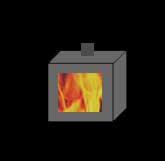
Radiant Wood Firebox
|
|

Outer Shell Added
|
|
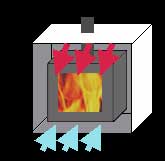
Natural Air Convection
|
Blowers are often added to increase the flow of room air through the heat exchange chamber while creating air turbulence in the room to promote a
more efficient "mix" of heated air with room air. Many manufacturers locate the blower in the bottom opening of the heat exchanger, where it
impedes the natural flow of air when it isn't running. In bigger, higher output inserts, this can not only interfere with the transfer of heated air into
the room whenever the blower isn't running, but also cause extreme temperature buildup in both the heat exchange chamber and the firebox, which
can damage the blower or firebox components. We're betting that the origin of your concern might have been one of those manufacturers' websites
or owner's manuals, which strongly caution against operating their inserts with the blowers turned off.
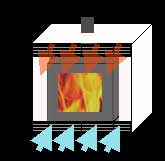
Blower in bottom opening-
increased airflow when on
|
|
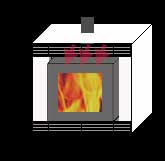
Blower off - impedes
natural airflow
|
You'll find no such precaution in your Pacific Summit Insert manual. This is just one of the reasons Pacific Energy has risen to
the top of the woodstove marketplace in both the US and Canada in recent years, and boils down to an elegant piece of thermal design engineering.
The blowers on the Summit,
Neo 2.5,
Alderlea T5,
Pacific Super and
Neo 1.6 insert models are mounted in the side openings of the heat exchange chamber, and blow
heated air sideways through the heat exchange chamber, where it encounters specially designed air deflectors which direct the airflow upwards,
across the top plate, and into the room through the top opening, while leaving the natural bottom-to-top air transfer channel unblocked. Thus, these models can be operated without the blower running with no fear of component damage caused by
overheating.

PE's Unique Blower Design
Blowers in side openings-
blow air out top opening
|
|
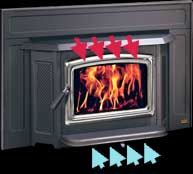
Off-The-Grid Performance
Blower off - natural
airflow unimpeded
|
You also needn't be concerned about reduced heating efficiency. When the air in the exchanger is allowed to flow naturally, it enters the room at a
very high temperature. When a blower is used to create more velocity through the heat exchanger, MORE air comes out FASTER, but, because the
available heat from the fire is spread out over more air molecules, it also comes out proportionately COOLER. The net delivery of convected heat
into the room is virtually unchanged.
Many of our customers use their PE insert blowers only when they're trying to bring a cold house up to temperature quickly: the added
velocity of air through the heat exchanger causes the heated air to blend with the room air faster, and also creates turbulence in the room which
promotes the flow of heated air into other rooms. As you've already discovered, once the living space has been brought up to temperature, the
natural circulation of air throughout a typical house is often all that is needed to maintain that temperature. At that point, the insert's blower can be
turned off with no fear of negative consequences.
|

